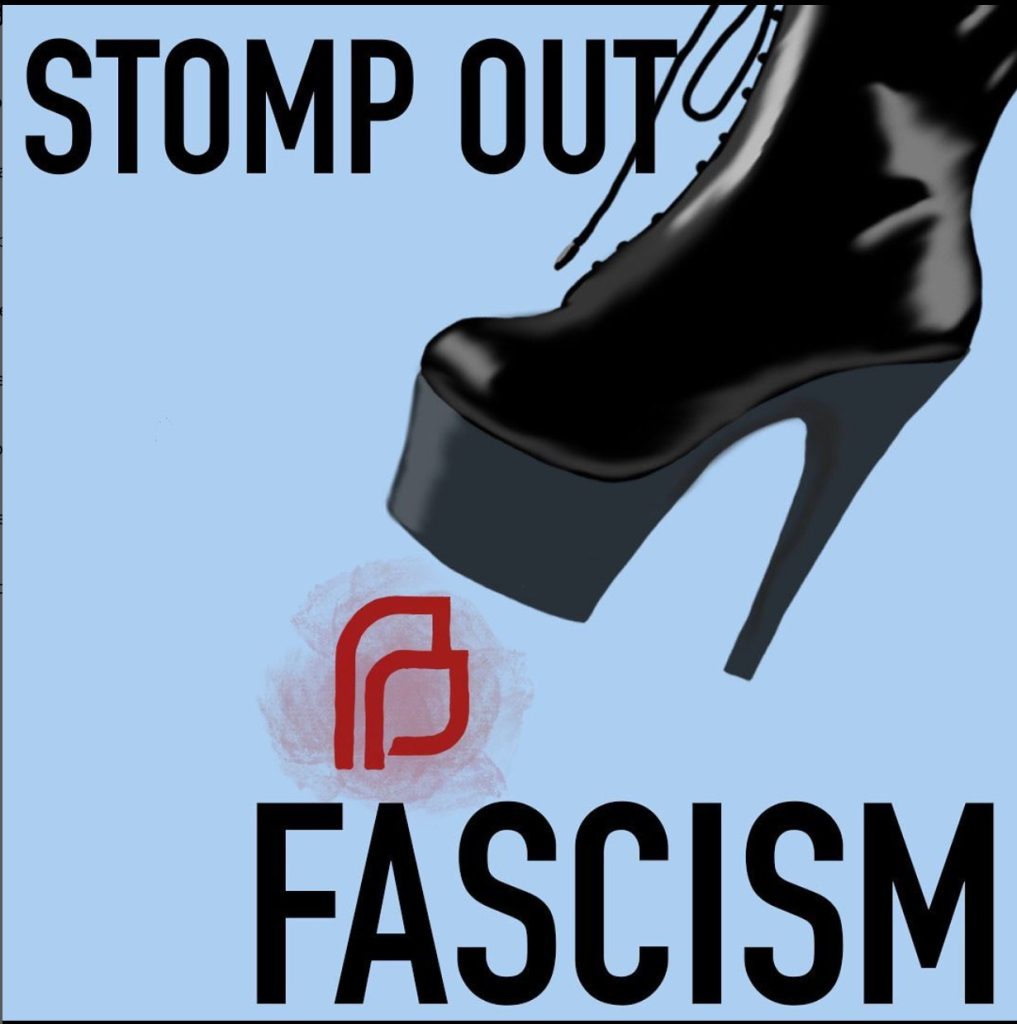I follow lots of feminist pages. I’m in lots of feminist and leftist groups. I’m in different agnostic and atheist groups. There’s all sorts of stuff out there, and I do regularly see pro-choice posts. I think it’s kind of funny that people stereotype pro-lifers as all right, religious, conservative men, because I’m like, you’re speaking freely about abortion in spaces that you think are free from pro-lifers. But little did you know we are here. – Treeflower, anti-abortion activist
At The University of Texas at Austin’s Propaganda Research Lab, we have spent the last year—since Dobbs v. Jackson Women’s Health Organization overturned Roe v. Wade and the federal right to abortion in the United States—interviewing and observing anti-abortion activists online, including their shifts in narratives. Rather than relying on rhetoric traditionally used by American conservatives, younger activists are also deploying feminist, anti-racist, and queer talking points to spread their messaging. In June 2023, which is both pride month in the United States and the anniversary of the Dobbs decision, we have increasingly seen anti-abortion activists mobilise queer discourse and imagery in support of policies that are fundamentally anti-LGBTQIA+. Using these discourses, anti-abortion activists are further polarising society and fostering extremism as they are radically uncompromising in their views. Critically, offline threats and violence against abortion clinics have increased since Roe was overturned.
Treeflower, quoted above, is just one of the many anti-abortion activists that we have spoken to and observed who are working to craft the narrative that the anti-abortion movement is progressive, cool, young, and ‘queer’. Through co-opting not only the language but also the imagery and music of Gen Z queer communities and people of colour, anti-abortion activists are reframing the anti-abortion cause. Anti-abortion is no longer just for “[politically] right, religious, conservative” and especially white people, they argue. The ‘post-Roe generation’ is cool.
Making Anti-abortion ‘Queer’
An Instagram post depicts a drawing of a black platform-heeled boot poised over Planned Parenthood’s logo, which appears smeared with blood. The accompanying text says, “Stomp out fascism” (Fig. 1). A rainbow flag is decorated with a drawing of a small foetus and the text, “Happy Pride!!” A young woman wearing black lipstick, cat eye eyeliner, and a pin of a foetus in rainbow runs through anti-abortion talking points, claiming to “debunk common disinformation.” An Instagram user’s bio reads, “Queer rights begin at conception .”

Fig. 1: ‘Stomp out Fascism’ anti-abortion meme
Historically, the anti-abortion community in the United States has been tied to religion, conservatism, and white supremacy. The initial criminalisation of abortion throughout the country in the late 19th and early 20th century was partially motivated by concerns of white people being ‘replaced’ by immigrants—what we now know as the Great Replacement theory. As recently as 2022, Republican Rep. Mary Miller stated that the overturning of Roe was a “historic victory for white life” (albeit allegedly mistakenly). This trend continues—a 2022 survey found ties between the American right, white supremacy, and anti-abortion ideology.
The Great Replacement conspiracy theory is tied not only to white supremacy but also to rhetoric that LGBTQIA+ people are sexual predators who plan to replace cisgender, straight people. In our social media observation, we saw many examples of this rhetoric, which combines the Great Replacement with ‘Save the Children’, a QAnon-adjacent conspiracy often promulgated by white conservative women. For instance, anti-abortion activists claimed that gender-affirming care for children is “child abuse”; that trans women transition for the purpose of preying on young girls; that in the future, anyone who identifies as cisgender will be sent to a “cis conversion camp;” and that drag queens are part of a “war on children”. This discourse persists in the many anti-LGBTQIA+ bills that are currently sweeping the nation.
But increasingly, anti-abortion political influencers are drawing on LGBTQIA+ imagery—like rainbows, platform heels, and counterculture fashion—to rope in Gen Z voters and convince people seeking abortions to continue their pregnancies. This is counter to the typical alliance between anti-LGBTQIA+ and anti-abortion groups. Yet, they are using this new strategy to stop abortion-seekers from accessing care:
“As someone who’s in lots of left-wing, feminist secular spaces, I kind of have a feeling there’s going to be more and more people who are like, ‘Hey, everyone! Here’s how we get abortions,’ and then I can swoop in and be like, ‘Hey, here’s the reality of abortion. Here’s some help for you’” one anti-abortion activist told us.
There remain those who are prominent in the movement that continue to rely heavily on anti-LGBTQIA+ rhetoric—Kristan Hawkins and Abby Johnson, for instance, are vocal about their anti-trans positions on Twitter. But many others are taking a different tack: align the rights of queer people with those of foetuses. One meme, created by a self-proclaimed “gay pro-lifer,” shows two men’s hands clasped—one Black, one white. The Black hand is labelled “Queer humans” and the white “Unborn humans” and the text over the hands reads, “Having the government sanction violence against you because they believe that you are less human.”

Fig. 2: ‘Pro-life & Gay’ meme
Through crafting witty memes and showcasing racial harmony, these activists are signalling that they are a new generation of the movement, distinct from the anti-abortion activists of the past. In our data, these activists tend to be young, counterculture, anti-government, and believe themselves to be fighting against the hegemonic oppression of queer people and foetuses. Again, demonstrating that she does not align herself with American conservatives, Treeflower told us:
“The police tend to be people who support abortion or domestic violence, or it’s very pro-choice leaning. So that’s why we’re seeing a lot of pro-life activists get arrested for doing things like rescues, or even just general sidewalk counselling.”
Even more critically, Treeflower and anti-abortion activists like her reframe the pro-choice movement as the side that oppresses and abuses women, people of colour, and queer people.
Making Anti-abortion ‘Gen Z’
As Treeflower pointed out, the anti-abortion community is perceived as older than the pro-abortion rights movement, and not without cause—younger people tend to be more pro-choice than older people. But the ‘post-Roe generation’ aims to change that. We observed thousands of posts and stories that featured young, multicultural people advocating against abortion rights. They used Gen Z rhetoric, like calling abortion “cringe” (to mean uncool). They encourage commodity activism—making political choices through where one chooses to shop. Not only that, but these posts were often accompanied by songs that are popular among young users on Instagram Reels and TikTok—rap songs by young Black female artists, for instance. Further, anti-abortion activists mobilised Reels and TikTok trends—the GRWM (Get Ready With Me) videos in which people put on their makeup and do their hair while speaking directly into the camera, or ‘Stitch’, in which people share a TikTok and add their own video to it. These tactics make anti-abortion rhetoric salient to Gen Z Instagram and TikTok users—the messaging is put into a form that is palatable for decreasing attention spans.

Fig. 3: Gen Z aesthetic anti-abortion meme
Making Anti-abortion ‘Hot’
The final tactic we observed is the anti-abortion movement’s goal to make pro-life viewpoints ‘hot’. Conventionally attractive women grace the feeds of both large, established anti-abortion organisations and new, emerging activist accounts. “Hot girl summer is valuing life and the preborn,” one post reads. Another claims, “Hot girls hate abortion.” This is a critical element of the strategy, as it particularly takes aim at young women. It is tied to their goal to make anti-abortion ‘feminist’, and not only targets women but also is promulgated by them. Recent research demonstrates that women are active and successful spreaders of extremism, in part due to their ability to ‘soften’ extremist rhetoric. Our data show that female anti-abortion activists are particularly prolific in spreading content, both by making the identity appear ‘hot’ and by making it ‘feminist’. One post reads, for example, “Every strong woman was once a helpless child.” Many of the posts employ a feminist aesthetic—authentic but polished, with pastel colours and shades of pink. They thus put forth an individualised and popular feminism, rather than a collective and political one.
All of these strategies work in service of making the anti-abortion messaging palatable to a new kind of voter—a young, multicultural, queer voter who might not otherwise vote for politicians who support anti-abortion policies. Yet, the larger narratives of the anti-abortion movement remain the same—that trans people harm the nuclear family; that there is nothing more rewarding than being a ‘traditional’ wife who stays home with her children and is not a ‘girl boss’; and that those who support abortion are ‘Satanists’. Despite the new packaging, the goals are the same—the anti-abortion movement continues to push conspiracy theories like the Great Replacement and Save the Children. Critically, these posts are often filled with disinformation about the science and policies behind abortion. The anti-abortion movement desires and plans to ban abortion in all forms—federally – and they know that they need Gen Z to do it.
Given the existing history of anti-abortion violence, new tactics in rhetoric and recruitment should be watched as they could be combined with offline attacks against reproductive care. This extremism threatens not just bodily autonomy, but also democracy and the physical safety of abortion seekers, doctors, and activists. Technology companies could moderate violent threats and disinformation surrounding reproductive health more closely while ensuring that accurate information remains protected and accessible. The abortion rights activists we interviewed, for instance, informed us that there are catalogues of activists’ names and addresses on social media, collected for the purpose of doxing and threatening pro-abortion rights groups, that have gone unaddressed by tech companies.
